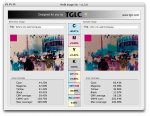SWOP or GRACoL CMYK as a lowest common denominator doesn't cut it...
A good argument, thank you, and great reason for RGB. Which brings us to an underlying consideration: which is more important, matching across media, or getting the most from each media used?
I'm a printer for life, so of course I'm looking at it from that perspective. For example, some of our work is fine art reproduction, most of which is produced using conventional offset tuned to G7, and undergoes considerable color correction to "get it just right." When that client wants to sell prints on a website, it is far more important that the potential buyer see an example of the product that is close to the actual product. If the actual product wasn't an art reproduction, say instead it was a plastic red toy fire truck, then accessing the wider gamut would be the obvious choice. In the end, the argument brings up important points that users should consider, which is a good thing.
As one coming from the world of printing, if I may speak for others, I think many of us still quiver when RGB images come in the door because of the terrible experiences we had, oh, say ten years ago. Things did not work so well back then, and RIPs in those days would produce some horrific results when fed RGB.
The color management modules in modern workflows and application software are far improved in this better future in which we have arrived. I am far less worried when ApogeeX sends up an RGB notification. With the proper profiles in the workflow, the result is comparable to Photoshop. It was not even close once upon a time.
And I do have some clients that specifically hand over RGB because they want me to do the CMYK conversion rather than their photographer or designer. Specialization has value, even in this future. But I still couldn't bring myself to issue a broad statement to all my clients, that I want them submitting RGB. Not yet.
What bothered me about the article is imagining how some users take advice and run with it. This thread would make a good article that -- I hope -- would encourage users to listen to advice, but also consider how it applies to their specific situation. It reminds of years ago, the old wive's tale, "Never use a TIFF in XPress, only an EPS, because it comes out low res." It's not that it came out low res, it was jagged on the edges because XPress was doing what the user asked: clipping it (badly) because the user "left" the picture box set to none (default), instead of setting it to white. For years that was misinterpreted as "low res." (although, low res could happen as well, when the PPD was a 300 dpi ouput device...)
At any rate, a determination of a right or wrong way to do it may still be up in the air. On one hand, getting CMYK is what printers are used to, and most would prefer. But I can see the RGB-proponent's side of the argument, and there is a twist that bolsters it. One issue we primarily litho prep folks face daily: many CMYK images have the SWOP Web profile assigned (default), and have been converted to CMYK using that profile. Barf, at least to those of us not prepping for web presses, rather higher quality offset. In these cases, an RGB image would be better, provided it has the proper profile set, considering we now have workflows with quality color management modules embedded, or in the case of manual conversion, in the hands of a skilled operator using a preferred destination profile in Photoshop.
In a short time, perhaps it will become true, that we no longer care so much whether images are RGB or CMYK, or fuss over it as much, as workflow and application software improves even more. I hope that is the case.














